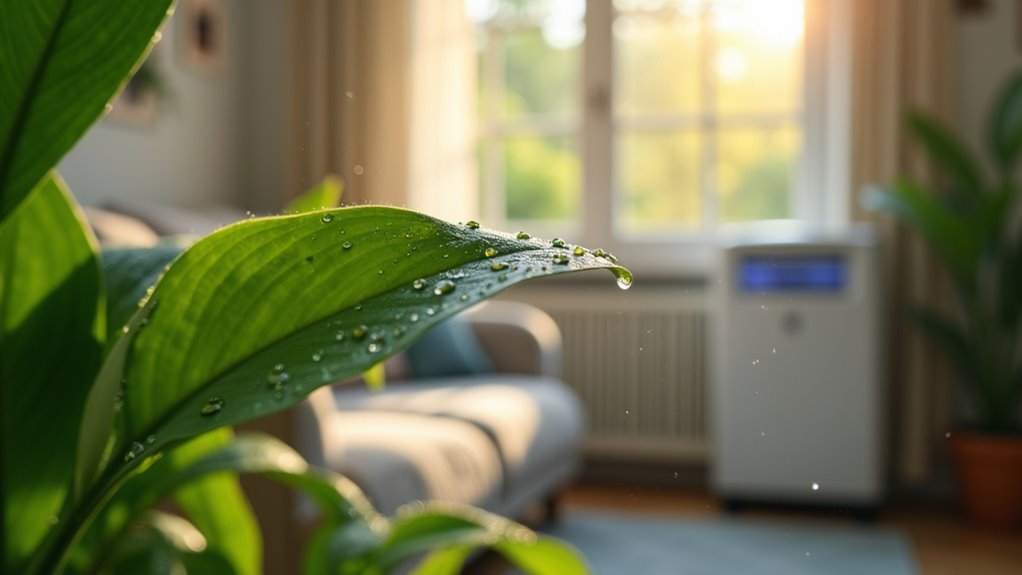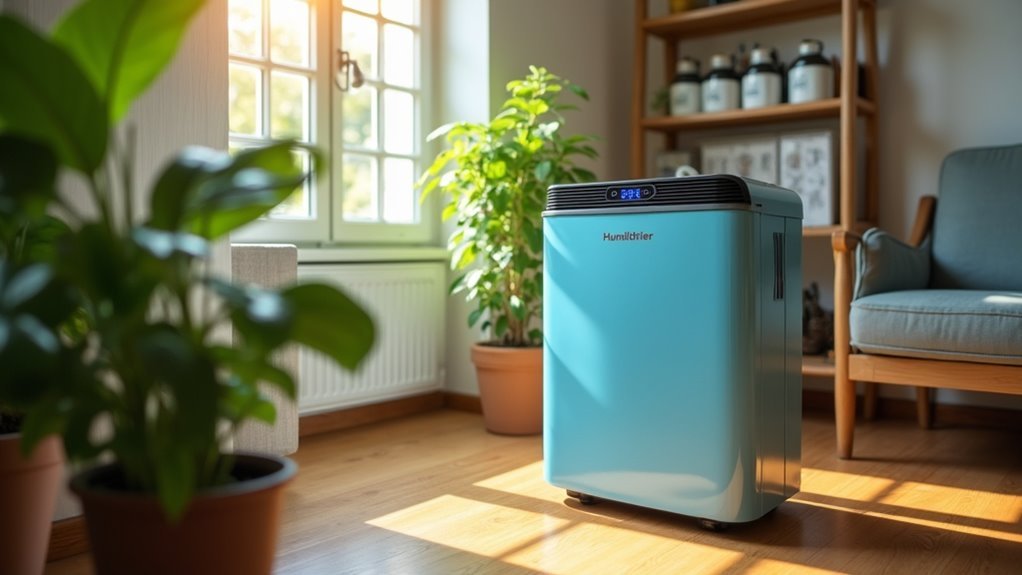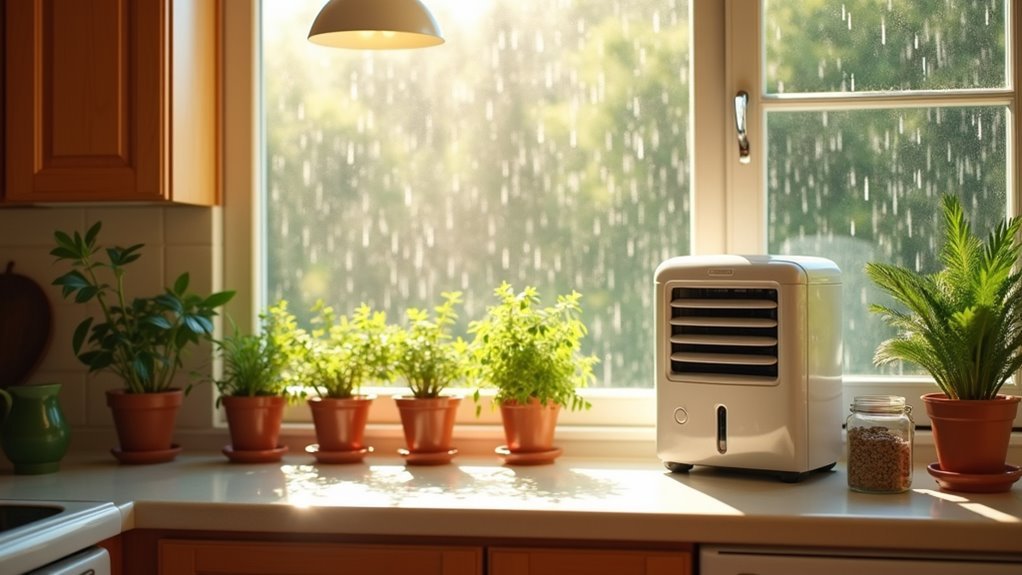You’ll prevent most pest infestations by maintaining indoor humidity levels between 30-50%. High humidity above 50% creates perfect breeding conditions for cockroaches, termites, dust mites, and silverfish while encouraging mold growth that attracts carpenter ants. Use dehumidifiers in moisture-prone areas like bathrooms, kitchens, and basements, install proper ventilation with exhaust fans, and monitor levels with hygrometers. Watch for warning signs like musty odors, window condensation, and increased pest sightings that indicate your humidity control strategies need immediate adjustment.
Understanding the Connection Between Humidity and Pest Infestations

When moisture levels in your home climb above ideal ranges, you’re fundamentally rolling out the red carpet for unwanted guests. High humidity creates perfect breeding conditions for cockroaches, termites, and dust mites that thrive in damp environments.
These pests need moisture for survival and reproduction, making your humid home their ideal habitat.
Poor ventilation in bathrooms and kitchens compounds the problem, trapping moisture from daily activities. Excess humidity also promotes mold growth, which attracts carpenter ants and other destructive pests.
Managing humidity by maintaining indoor humidity levels between 30-50% is essential for preventing pest infestations. Without proper humidity control, you’ll likely need pest control services to address problems that could’ve been avoided through effective moisture management.
Identifying Common Moisture-Loving Pests in Your Home
You’ll often find cockroaches lurking in the darkest, most humid corners of your kitchen and bathroom where they can multiply quickly.
Termites actively seek out moisture-damaged wood throughout your home, creating extensive tunnel networks that compromise your property’s structural integrity.
Silverfish congregate in your basement’s damp spaces, quietly feeding on paper goods, fabrics, and pantry items while thriving in high-humidity conditions.
Cockroaches and Dark Spaces
Where do cockroaches prefer to establish their colonies in your home? These resilient pests gravitate toward dark spaces with high humidity levels, making kitchens and bathrooms their preferred breeding grounds.
You’ll find them lurking behind appliances, under sinks, and in cabinet crevices where moisture control becomes challenging.
Cockroaches thrive in these damp areas because they need water to survive and reproduce. A single female can produce up to 300 offspring in her lifetime, turning minor pest problems into major infestations quickly.
Their presence creates serious health risks, contaminating surfaces and compromising indoor air quality through allergens and bacteria.
Effective thorough pest management requires targeting these moisture-rich environments. You’ll need to eliminate water sources, improve ventilation, and seal entry points to prevent cockroaches from establishing colonies in your home’s dark, humid spaces.
Termites Target Damp Wood
While cockroaches threaten your health through contamination, termites pose an entirely different danger to your home’s structural integrity.
These destructive pests specifically target damp wood, making humidity control essential for pest prevention. You’ll find termites creating mud tubes between their nests and food sources, often signaling excessive indoor moisture levels.
A single colony can devour half a pound of wood daily, causing devastating structural damage over time.
Watch for signs of pests like hollow-sounding wood, discarded wings, and visible mud tubes along your foundation.
Effective moisture management starts with addressing water leaks promptly and maintaining low humidity levels throughout your home.
Silverfish Prefer Humid Areas
Unlike termites that attack your home’s structure, silverfish threaten your belongings by feeding on paper, clothing, and starchy materials throughout your house.
These wingless pests flourish in humid environments, particularly targeting damp areas like basements, bathrooms, and laundry rooms where moisture levels remain consistently high.
Effective silverfish prevention requires thorough humidity control throughout your home:
- Maintain indoor humidity below 50% using dehumidifiers and proper ventilation systems
- Inspect moisture-prone areas regularly including under sinks, around water heaters, and in storage spaces
- Improve air circulation in confined spaces where silverfish typically hide and reproduce
You’ll protect your valuable books, wallpaper, and household items by controlling moisture levels.
Since silverfish can’t survive without adequate humidity, consistent moisture management eliminates their preferred living conditions before infestations develop.
Recognizing High-Risk Humidity Zones Throughout Your Property
You’ll find that certain areas of your home naturally trap moisture and create perfect breeding grounds for pests.
Your bathrooms, kitchens, basements, and attics represent the most vulnerable zones where humidity levels spike due to daily activities, poor ventilation, or structural weaknesses.
Understanding these high-risk areas and how seasonal changes affect moisture patterns will help you target your pest prevention efforts more effectively.
Indoor Humidity Hotspots
Where exactly do humidity levels spike throughout your home, creating perfect breeding grounds for unwanted pests? Several areas consistently trap moisture, requiring your immediate attention and proper ventilation strategies.
Your bathrooms top the list due to steamy showers and baths. Without adequate exhaust fans, this moisture lingers and attracts pests seeking damp environments.
Kitchens generate significant humidity from cooking activities, particularly boiling water and dishwashing, making ventilation essential for moisture control.
Consider these primary humidity hotspots:
- Basements and crawl spaces – Poor air circulation below ground level creates ideal pest conditions.
- Laundry rooms – Washing machines and dryers generate excessive moisture without proper ventilation.
- Areas showing condensation – Windows displaying water droplets or rooms with musty odors indicate dangerous humidity levels requiring dehumidifiers.
Structural Vulnerability Areas
Beyond these common moisture-prone areas, your home’s structural design creates additional vulnerability zones that trap humidity in ways you mightn’t expect.
While kitchens and bathrooms generate obvious moisture through daily activities, basements and crawl spaces face unique challenges due to poor ventilation and below-ground positioning. These high-risk zones naturally accumulate dampness, creating perfect breeding grounds for pests.
Your attic represents another critical vulnerability point where inadequate insulation and ventilation cause humidity retention through temperature fluctuations.
You’ll want to regularly inspect these structural areas for leaks, condensation, and moisture signs before pest problems escalate.
Installing hygrometers throughout these zones helps you monitor humidity levels effectively.
Maintaining levels between 30-50% creates an environment that deters pest infestations while protecting your home’s structural integrity.
Seasonal Risk Zones
As seasons change throughout the year, different areas of your property become humidity hotspots that dramatically increase pest attraction and infestation risks.
Understanding these seasonal patterns helps you prevent infestations before they start.
High-Risk Humidity Zones by Season:
- Winter Focus Areas – Bathrooms and kitchens experience heightened moisture from steam and cooking activities when ventilation is often reduced, creating ideal conditions for mold and pest breeding.
- Year-Round Vigilance – Basements maintain consistently damp conditions with poor airflow, making them perfect breeding grounds for cockroaches and mold mites regardless of season.
- Summer Hotspots – Poorly ventilated attics trap humid air, while increased rainfall creates water pooling around foundations that attracts pests seeking moisture sources.
Monitor humidity levels above 60% using hygrometers in these zones.
Essential Tools and Techniques for Measuring Indoor Moisture Levels
Accurate moisture measurement forms the foundation of effective humidity management, and hygrometers serve as your primary weapon against pest-attracting conditions. These essential tools provide precise humidity levels data, helping you maintain ideal indoor环境 between 30-50%. Place hygrometers strategically in moisture-prone areas like basements, kitchens, and bathrooms for thorough monitoring.
| Location | Ideal Humidity Range |
|---|---|
| Basement | 30-40% |
| Kitchen | 40-50% |
| Bathroom | 40-50% |
| Living Areas | 35-45% |
| Bedrooms | 30-45% |
When readings consistently exceed 60%, you’re inviting pest infestations. Implement proactive measures by pairing hygrometers with dehumidifiers in problematic zones. Regular moisture monitoring enables early detection of humidity spikes, allowing immediate pest control intervention. This systematic approach improves air quality while creating an inhospitable environment for unwanted guests.
Proven Methods to Control and Reduce Excess Humidity

Once you’ve identified problematic humidity levels through monitoring, implementing targeted reduction strategies becomes your next critical step.
Controlling indoor humidity requires a multi-faceted approach that targets moisture sources and promotes proper air circulation to maintain your pest-free home.
Here are three proven methods to effectively reduce excess humidity:
- Install dehumidifiers in moisture-prone areas like basements and bathrooms to maintain ideal humidity levels between 30-50%, making your environment less attractive to pests.
- Ensure proper ventilation with exhaust fans in kitchens and bathrooms to expel moisture from cooking and showering activities.
- Seal plumbing leaks and structural gaps while installing vapor barriers in crawl spaces to prevent moisture entry and accumulation that attracts unwanted pests.
Warning Signs That Your Humidity Control Efforts Are Failing
Even with the best humidity reduction methods in place, your efforts mightn’t be working as effectively as you think. Several warning signs indicate your moisture control systems need immediate attention.
Persistent musty odors throughout your home signal that humidity levels remain too high, creating perfect conditions for pests and mold growth. Regular condensation on windows, especially during colder months, suggests your ventilation and dehumidifiers aren’t adequately managing indoor moisture.
Watch for soft walls or misaligned doors, which indicate moisture damage that attracts pests. Frequent mold or mildew appearing in bathrooms and basements means your current humidity control measures are failing.
Most telling are increased cockroach sightings, as these pests thrive in moist environments and signal significant humidity problems.
Implementing Year-Round Moisture Management Strategies

Since moisture levels fluctuate dramatically throughout the year, you’ll need a thorough approach that adapts to seasonal changes and maintains consistent humidity control.
Effective moisture management requires strategic planning and consistent implementation to prevent pest issues before they develop.
Strategic moisture control with year-round planning prevents costly pest infestations before they start in your home.
Your year-round strategy should include:
- Seasonal equipment adjustments – Run dehumidifiers during humid summer months and monitor humidity levels with hygrometers to maintain the ideal 30-50% range that deters pests.
- Consistent ventilation practices – Guarantee proper ventilation through exhaust fans in kitchens and bathrooms year-round, regardless of outdoor conditions.
- Proactive maintenance – Regularly inspect and seal plumbing leaks to reduce moisture accumulation and eliminate potential breeding grounds.
Smart homeowners understand that preventing humidity-related pest problems requires dedication throughout all seasons, not just reactive responses to infestations.
Professional Vs DIY Approaches to Humidity-Related Pest Prevention
When you’re facing humidity-related pest problems, you’ll need to decide whether to tackle the issue yourself or call in professional pest control services.
| Aspect | DIY Methods | Professional Services |
|---|---|---|
| Cost | Lower upfront investment in dehumidifiers and ventilation improvements | Higher initial cost but potentially more cost-effective long-term |
| Expertise | Limited knowledge of humidity-related issues and pest identification | Specialized expertise in identifying specific problems and tailored solutions |
| Equipment | Consumer-grade dehumidifiers and basic ventilation tools | Advanced equipment and professional-grade products for controlling moisture levels |
| Strategy | Immediate fixes with consistent monitoring required | Thorough preventative measures and long-term strategies to prevent pest infestations |
DIY approaches can effectively manage humidity through proper ventilation and dehumidification, but professional services offer specialized knowledge and equipment that address underlying humidity-related issues more thoroughly.
Frequently Asked Questions
What Is the Best Humidity Level to Prevent Bugs?
You’ll want to maintain humidity between 30% and 50% to prevent bugs. Levels above 60% create ideal breeding conditions for cockroaches, dust mites, and mold, greatly increasing your risk of pest infestations.
What Are the Three Basic Rules for Keeping a Pest-Free Facility?
You’ll maintain proper humidity levels between 30-50%, eliminate food sources by storing items in airtight containers, and conduct regular inspections to catch pest activity early before infestations develop.
What Is the Best Way to Control House Humidity?
You’ll control house humidity best by using dehumidifiers in damp areas, installing exhaust fans in kitchens and bathrooms, fixing leaks promptly, and improving airflow with windows and ceiling fans.
Why Is My House Always 70% Humidity?
Your house maintains 70% humidity because you’re likely dealing with poor ventilation, moisture from cooking and showering, or structural issues like leaks and inadequate insulation allowing moisture infiltration.
In Summary
You’ve got the power to keep pests at bay by controlling humidity levels in your home. Don’t wait until you’re dealing with an infestation—start monitoring moisture levels today. Whether you choose DIY solutions or professional help, consistent humidity management will protect your property year-round. Remember, preventing pest problems is always easier and cheaper than eliminating them after they’ve already moved in and made themselves comfortable.





Leave a Reply